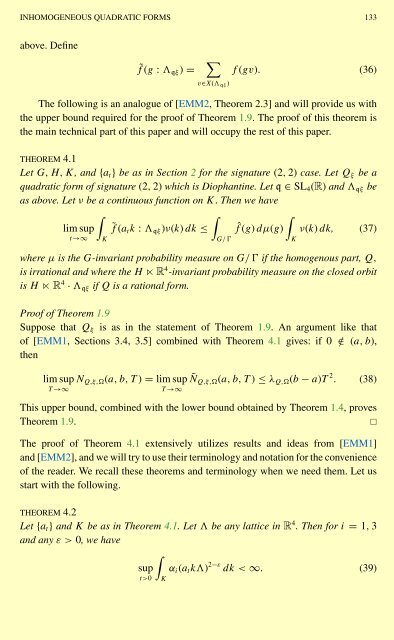NEAR OPTIMAL BOUNDS IN FREIMAN'S THEOREM
NEAR OPTIMAL BOUNDS IN FREIMAN'S THEOREM
NEAR OPTIMAL BOUNDS IN FREIMAN'S THEOREM
Create successful ePaper yourself
Turn your PDF publications into a flip-book with our unique Google optimized e-Paper software.
<strong>IN</strong>HOMOGENEOUS QUADRATIC FORMS 133<br />
above. Define<br />
f ˜(g<br />
: qξ) = <br />
v∈X(qξ )<br />
f (gv). (36)<br />
The following is an analogue of [EMM2, Theorem 2.3] and will provide us with<br />
the upper bound required for the proof of Theorem 1.9. The proof of this theorem is<br />
the main technical part of this paper and will occupy the rest of this paper.<br />
<strong>THEOREM</strong> 4.1<br />
Let G, H, K, and {at} be as in Section 2 for the signature (2, 2) case. Let Qξ be a<br />
quadratic form of signature (2, 2) which is Diophantine. Let q ∈ SL4(R) and qξ be<br />
as above. Let ν be a continuous function on K. Then we have<br />
<br />
<br />
<br />
lim sup<br />
t→∞<br />
˜f (atk : qξ)ν(k) dk ≤ f ˆ(g)<br />
dµ(g)<br />
K<br />
G/ Ɣ<br />
K<br />
ν(k) dk, (37)<br />
where µ is the G-invariant probability measure on G/ Ɣ if the homogenous part, Q,<br />
is irrational and where the H ⋉R 4 -invariant probability measure on the closed orbit<br />
is H ⋉R 4 · qξ if Q is a rational form.<br />
Proof of Theorem 1.9<br />
Suppose that Qξ is as in the statement of Theorem 1.9. An argument like that<br />
of [EMM1, Sections 3.4, 3.5] combined with Theorem 4.1 gives: if 0 /∈ (a,b),<br />
then<br />
lim sup<br />
T →∞<br />
NQ,ξ,(a,b,T ) = lim sup ÑQ,ξ,(a,b,T ) ≤ λQ,(b − a)T<br />
T →∞<br />
2 . (38)<br />
This upper bound, combined with the lower bound obtained by Theorem 1.4, proves<br />
Theorem 1.9. <br />
The proof of Theorem 4.1 extensively utilizes results and ideas from [EMM1]<br />
and [EMM2], and we will try to use their terminology and notation for the convenience<br />
of the reader. We recall these theorems and terminology when we need them. Let us<br />
start with the following.<br />
<strong>THEOREM</strong> 4.2<br />
Let {at} and K be as in Theorem 4.1. Let be any lattice in R 4 . Then for i = 1, 3<br />
and any ε>0, we have<br />
<br />
sup αi(atk)<br />
t>0 K<br />
2−ε dk < ∞. (39)

















